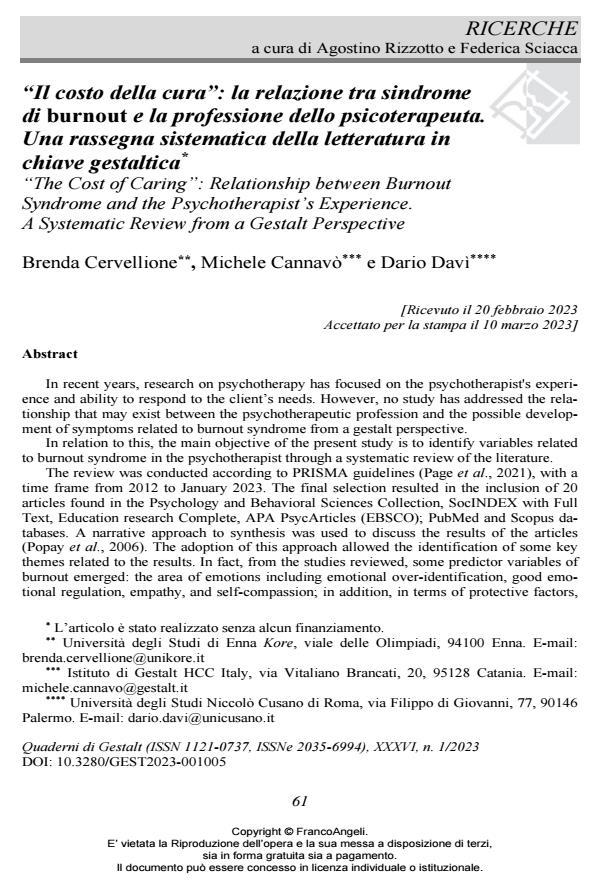"Il costo della cura": la relazione tra sindrome di burnout e la professione dello psicoterapeuta. Una rassegna sistematica della letteratura in chiave gestaltica
Titolo Rivista QUADERNI DI GESTALT
Autori/Curatori Brenda Cervellione, Michele Cannavò, Dario Davì
Anno di pubblicazione 2023 Fascicolo 2023/1
Lingua Italiano Numero pagine 18 P. 61-78 Dimensione file 300 KB
DOI 10.3280/GEST2023-001005
Il DOI è il codice a barre della proprietà intellettuale: per saperne di più
clicca qui
Qui sotto puoi vedere in anteprima la prima pagina di questo articolo.
Se questo articolo ti interessa, lo puoi acquistare (e scaricare in formato pdf) seguendo le facili indicazioni per acquistare il download credit. Acquista Download Credits per scaricare questo Articolo in formato PDF

FrancoAngeli è membro della Publishers International Linking Association, Inc (PILA)associazione indipendente e non profit per facilitare (attraverso i servizi tecnologici implementati da CrossRef.org) l’accesso degli studiosi ai contenuti digitali nelle pubblicazioni professionali e scientifiche
Obiettivo principale del presente studio è identificare le variabili connesse alla sindrome di burnout nel professionista della salute mentale, nello specifico dello psicoterapeuta attraverso una revisione sistematica, condotta secondo le linee guida PRISMA (Page et al., 2021), con un arco temporale che va dal 2012 a gennaio 2023. La selezione finale ha portato all’inclusione di 20 articoli trovati sui database Psychology and Behavioral Sciences Collection, SocINDEX con Full Text, Education research Complete, APA PsycArticles (EBSCO); PubMed e Scopus. Le variabili “empatia” e “risonanza corporea” sono risultate fondamentali per stabilire una mi-gliore qualità della relazione terapeutica, risultato in linea con i dati già ottenuti dalla ricerca sulla psicoterapia della Gestalt (Spagnuolo Lobb et al., 2022a). Un obiettivo comune per i cli-nici potrebbe essere quello di potenziare le attività di co-visione e supervisione clinica, soste-nendo la risonanza estetica e di campo (Spagnuolo Lobb et al., 2022b).
Parole chiave:Psicoterapia della gestalt; burnout, rassegna sistematica della letteratura, super-visione, benessere.
Brenda Cervellione, Michele Cannavò, Dario Davì, "Il costo della cura": la relazione tra sindrome di burnout e la professione dello psicoterapeuta. Una rassegna sistematica della letteratura in chiave gestaltica in "QUADERNI DI GESTALT" 1/2023, pp 61-78, DOI: 10.3280/GEST2023-001005